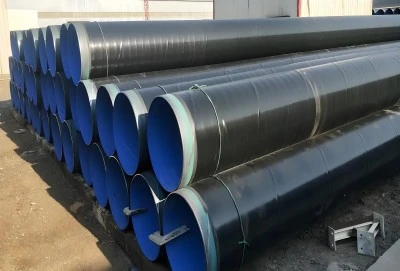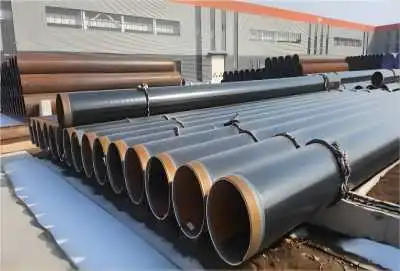First layer - Fusion Bonded Epoxy (FBE)
The 3PE coating pipe begins with the application of Fusion Bonded Epoxy (FBE) as the first layer. This initial layer is crucial as it provides excellent adhesion to the steel pipe surface and offers significant corrosion protection. The FBE application process involves several carefully controlled steps to ensure optimal coating performance.
Before applying the FBE layer, the steel pipe surface must be meticulously prepared. This typically involves abrasive blasting to remove any rust, mill scale, or contaminants and to create a specific surface profile. The cleanliness and roughness of the pipe surface are critical factors in achieving proper adhesion of the FBE coating.
Once the surface is prepared, the pipe is preheated to a temperature above the melting point of the epoxy powder, usually around 200°C to 250°C (392°F to 482°F). The exact temperature depends on the specific FBE formulation being used. Preheating serves two purposes: it helps to remove any remaining moisture from the pipe surface and ensures that the epoxy powder will melt and flow properly upon contact.
The FBE powder is then applied using an electrostatic spray system. The powder particles are electrically charged as they are sprayed towards the grounded, preheated pipe. This electrostatic charge helps the powder particles adhere evenly to the pipe surface, ensuring uniform coverage. As the powder contacts the hot pipe surface, it immediately melts and flows to form a continuous coating.
After application, the FBE coating undergoes a curing process. The pipe passes through a curing oven where the epoxy cross-links and hardens, typically at temperatures between 200°C and 250°C (392°F to 482°F). The curing time and temperature are carefully controlled to achieve the desired coating properties, such as hardness, chemical resistance, and adhesion strength.
The thickness of the FBE layer in a 3PE coating system is typically between 125 and 250 microns (5 to 10 mils). This relatively thin layer provides an excellent barrier against corrosion and serves as a strong foundation for the subsequent layers of the 3PE coating system.
|
|
|
Second layer - Adhesive
The second layer in the 3PE coating pipe is an adhesive layer, which plays a critical role in bonding the FBE layer to the final polyethylene outer layer. This intermediate layer is typically a modified polyethylene adhesive, chosen for its compatibility with both the epoxy and polyethylene materials.
The application of the adhesive layer begins immediately after the FBE layer has been applied and cured. Timing is crucial in this step to ensure optimal bonding between the layers. The pipe, still warm from the FBE curing process, passes through an extruder that applies the molten adhesive material.
The adhesive used in 3PE coating pipes is typically a grafted polyethylene. This material is created by modifying polyethylene with maleic anhydride or similar compounds, which enhances its ability to bond with both the polar epoxy surface and the non-polar polyethylene outer layer. The grafted polyethylene adhesive provides both chemical bonding and mechanical interlocking between the layers.
The thickness of the adhesive layer is carefully controlled, usually ranging from 150 to 300 microns (6 to 12 mils). This thickness is sufficient to ensure complete coverage and strong bonding, while not being so thick as to compromise the overall coating performance.
Temperature control during adhesive application is critical. The adhesive must be hot enough to flow and wet the FBE surface effectively, but not so hot as to degrade the underlying FBE layer. Typical application temperatures for the adhesive layer range from 180°C to 220°C (356°F to 428°F).
The adhesive layer not only provides bonding between the FBE and polyethylene layers but also contributes to the overall corrosion protection of the coating system. It acts as an additional barrier against moisture and other corrosive elements, enhancing the long-term performance of the 3PE coating.
Third layer - Polyethylene (PE)
The final and outermost layer of the 3PE coating system is the polyethylene (PE) layer. This layer provides mechanical protection, impact resistance, and additional barrier properties to the coating system. The polyethylene used is typically high-density polyethylene (HDPE) or medium-density polyethylene (MDPE), chosen for their excellent combination of strength, flexibility, and chemical resistance.
The application of the PE layer follows immediately after the adhesive layer, while the pipe is still at an elevated temperature. This ensures good bonding between the adhesive and PE layers. The polyethylene is applied using an extrusion process, where molten PE is forced through a die to form a continuous sleeve around the pipe.
The extrusion process for the PE layer requires precise control of several parameters. The temperature of the molten polyethylene typically ranges from 200°C to 230°C (392°F to 446°F), depending on the specific grade of PE being used. The extrusion speed and cooling rate are carefully managed to ensure uniform coating thickness and to minimize residual stresses in the coating.
The thickness of the PE layer can vary depending on the specific requirements of the pipeline project, but it typically ranges from 2 to 3.5 mm (80 to 140 mils). This substantial thickness provides significant mechanical protection against impacts, abrasion, and soil stress for buried pipelines.
After extrusion, the coated pipe passes through a series of water baths or spray cooling systems to solidify the PE layer. The cooling process must be controlled to prevent rapid temperature changes that could induce thermal stresses in the coating. Some coating lines may employ air cooling or a combination of water and air cooling to achieve the desired cooling profile.
The final step in the 3PE coating process is often a series of quality control checks. These may include holiday testing to detect any pinholes or thin spots in the coating, adhesion tests to ensure proper bonding between layers, and impact resistance tests to verify the mechanical properties of the coating system.
3PE Coating Steel Pipe For Sale
LONGMA GROUP is a leading manufacturer and supplier of 3PE coating pipes, offering high-quality products with impressively quick turnaround times. For customers seeking 3PE coating steel pipes, LONGMA GROUP boasts a remarkably fast delivery time of just 7 days for normal specifications. This rapid delivery capability can be crucial for projects with tight schedules or urgent requirements.
The company's expertise in the 3PE coating process ensures that their pipes meet stringent quality standards and provide excellent corrosion protection and mechanical resistance. Whether you're working on an oil and gas pipeline, water distribution system, or any other application requiring protected steel pipes, LONGMA GROUP's 3PE coated pipes can meet your project needs efficiently.
If you're in the market for 3PE coating pipes or need guidance on selecting the most appropriate specifications for your project, you can reach out to LONGMA GROUP directly at info@longma-group.com. Their team of experts can provide detailed information about their products, assist with technical specifications, and help ensure you choose the optimal solution for your pipeline project. With their combination of quality products and fast delivery times, LONGMA GROUP stands out as a reliable partner for your steel pipe coating needs.














